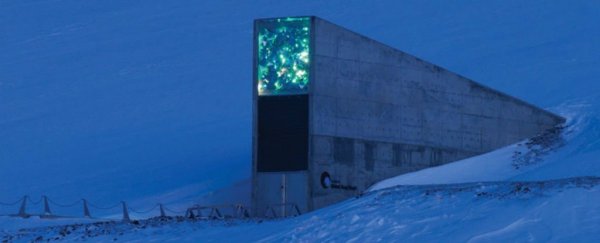The giant seed bank with the ominous nickname – the Arctic "doomsday vault" – has just faced its first real test as a fail-safe storage facility in the form of minor flooding from melting permafrost.
While none of the seeds at the Svalbard Global Seed Vault are in danger of getting wet, the shock of the melted permafrost has taken those involved with the project by surprise.
Opened in 2008, the facility on the Norwegian island of Spitsbergen currently protects over 1 million seed packets containing around 4000 of the world's most important crop species from any possible threats to our managed ecosystems, from asteroid strike to war.
Technically, the vault is a back-up of back-ups held all around the world, with the fact it's buried 1300 kilometres (over 800 miles) beyond the Arctic circle providing not just a remote stronghold, but a cold, dry environment that would continue to keep them safe if the power ever fizzled out.
Without electricity the vault is still expected to stay at around -5 degrees Celsius (23 degrees Fahrenheit) for the next two centuries, though with generators running it's kept at a numbing -18 degrees Celsius (-0.4 Fahrenheit).
Of course, staying cold and bone dry depends on the climate, which as we all know isn't trending in a chilly direction.
In fact, 2016 was the hottest year on the books since global temperatures were first noted down in 1880, a record broken just twelve months after the previous one had been set in 2015. Things weren't helped by an El Niño event, resulting in high temperatures that have melted permafrost in the Arctic circle and turned Spitsbergen's usual later winter dusting of snow into heavy rain.
"It was not in our plans to think that the permafrost would not be there and that it would experience extreme weather like that," Hege Njaa Aschim from the Norwegian government told Damian Carrington from The Guardian.
Rest assured the vault doesn't have a new underground swimming pool – it's buried about 122 metres (400 feet) into the side of a mountain with thick, solid concrete walls and a long entrance corridor sloping down, away from the facility's interior.
Yet water has breached that entrance, where it refroze and needed to be hacked out.
"A lot of water went into the start of the tunnel and then it froze to ice, so it was like a glacier when you went in," Aschim described.
Let Derek Muller from Veritasium give you a quick tour of the place to get a better idea of how it's structured.
What is concerning isn't so much the breach itself; even if it poured in, it would have to flow a fair way downhill, then up again, and fail to be removed by the pumping systems. Chances are it would freeze anyway, and form a barrier preventing more water from flooding inside.
But the fact the vault should operate neatly without human intervention means any threats need to be taken seriously. And a water-tight entrance simply wasn't in the plans.
"We must see what we can do to minimise all the risks and make sure the seed bank can take care of itself," said Aschim.
Water seeping in through the entrance is looking to be a yearly event and additional waterproofing is being carried out to deal with similar events in the near future, but it's not clear if this will be enough to keep the facility safe if the permafrost continues to melt, at least not without people around to continue maintenance.
"The tunnel was never meant to be water-tight at the front, because we didn't think we would need that," Cary Fowler, who helped build the vault, told Mary Beth Griggs at Popular Science.
"What happens is, in the summer the permafrost melts, and some water comes in, and when it comes in, it freezes. It doesn't typically go very far."
Global Warming isn't about to vanish any time soon, so the question is how is the seed vault is going to cope with rising temperatures in coming years.
"We have to find solutions. It is a big responsibility and we take it very seriously. We are doing this for the world," Aschim said.
Withdrawals have already been made from the bank; in 2015 seeds were taken to resupply Aleppo's seed bank after it was destroyed by intense bombing.
Similar "doomsday vaults" are also springing up in the Arctic to store things like important data, so the rate of climate change isn't going to just be a problem for long term storage of plant species.
Temperatures at the poles are rising faster than those over the rest of the planet's surface, meaning if bets are on, we can see more of this kind of thing in the future.
